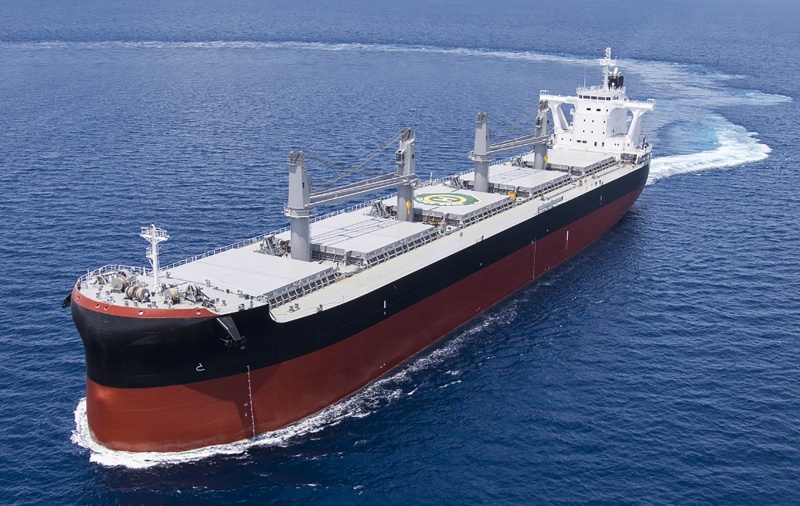〆Freight Forward Agreements (FFAs) have risen more than expected, leading to operations in deficit.

Asset-light players, who primarily transport cargo using spot and short-term chartered vessels, are struggling in the freight futures market (FFA = see glossary). Typically, the dry market significantly softens from January to March, but this year, the market trend is bullish due to detours around the Red Sea and drought in the Panama Canal. Maritime industry insiders have expressed their concerns, lamenting the slump due to the gap between charter rates and freight rates. “Short-term charter rates are benchmarked against the FFA futures index. Some of Japan’s tramp ship operators are paying high short-term charter rates and carrying low-freight cargo.” (Text by Hirofumi Yamamoto)
As of March 20, 2024, the spot charter rate for a medium-sized bulk carrier (Ultramax) in the London market was $15,067 per day, exceeding the average break-even point for an Ultramax of around $12,000 per day.
According to the trend of Freight Forward Agreements (FFAs), the rate is expected to rise further in April to $15,600, indicating a high-price trend.
Asset-light players refer to operators (shipping companies) that transport cargo contracted by themselves using spot or short-term chartered vessels, without owning their own ships or long-term chartered vessels.
When the shipping market crashed following the outbreak of the Lehman Shock in 2008, Japanese and European shipping operators with long-term charters incurred enormous charter fee debts. There were numerous bankruptcies related to the cancellation of long-term charters and loss management, along with many cases of unpaid charter fees.
Among Japanese ship operators, since the mid-2010s, some companies have been avoiding long-term charters in the dry sector, instead composing their fleets with medium-term and short-term chartered vessels.
FFAs are transactions that fix future spot freight rates or charter rates against the fluctuating real-world shipping market conditions.
Bulkers and tankers, which are key to the formation of the shipping market, primarily use FFAs, and Japanese shipping companies also adopt them from a risk hedging perspective.
Most Japanese ship operators engage in FFA transactions within the scope of their own ships or long-term charters. Meanwhile, some operators in Europe, effectively with “zero vessels on hand,” utilize FFAs to combine transported cargo with vessels.
Currently, the struggle in the FFA market is believed to be more due to the bullish outlook on short-term charter rates, which FFAs benchmark, rather than the FFA transactions themselves.
As of December 23, 2023, the Freight Forward Agreement (FFA) for an Ultramax vessel in December was $16,250, significantly higher than the spot charter rate of $15,063 on the same day.
Japanese ship operators often transport cargo such as those under a Contract of Affreightment (COA) with power companies by procuring vessels on the spot market.
When the actual charter rate at the time of transportation is higher than the expected charter rate for cargo contracted at a lower freight level, it leads to situations where operators are forced into operating at a loss.
In the current dry market, the availability of medium-sized bulkers in the Atlantic is tight, while there is a sense of excess capacity in the Pacific.
In the Atlantic, due to the circumvention of the Suez Canal and the Ukraine crisis, many global shipping companies have canceled their vessel allocations, leading to a scarcity of available spot ships.
Because the charter rates for Freight Forward Agreements (FFAs) are determined by the average of both the Atlantic and Pacific, the freight rates for cargoes in the Pacific, where a sense of excess ship capacity is prominent, remain low. The majority of contracts for Japanese ship operators are in the Pacific region.
Japanese ship operators, compelled to procure ship capacity, must charter bulkers on a short-term basis, with the FFA charter rates, which anticipate higher future rates, serving as the benchmark.
There have been instances where losses in the FFA market have led to changes in management.
■FFA stands for Forward Freight Agreement.
It’s a financial instrument used in the shipping industry that allows participants to hedge against the volatility of future spot freight rates by setting them in advance. There’s no actual chartering of vessels involved; instead, transactions are conducted for different types of ships. Because short-term charter and spot freight rates in the real market are prone to fluctuate wildly due to supply and demand factors, FFAs provide a way to lock in future spot freight rates beforehand, offering a measure of predictability and risk management for shipping companies.
〆日本の海運業界でも「アセットライト・プレーヤー」の苦戦が発生している。
〆FFA(Freight Forward Agreement)が想定以上に上昇、赤字運航が発生している。
スポット(随時契約)船や短期用船を中心に貨物を輸送する「アセットライト・プレーヤー」が運賃先物市場(FFA=ワード参照)で苦戦している。例年1―3月はドライ市況が大幅に軟化するが、今年は紅海の迂回(うかい)やパナマ運河の渇水で市況は先高に推移している。海運関係者は次のように話し、用船料と運賃のギャップによる不振を嘆いた。「短期用船料はFFAの先物指数がベンチマークになっている。日本の不定期船事業者の一部は割高な短期用船料を支払い、運賃の安い貨物を運んでいる」
2024年3月20日時点のロンドン市場での中型バルカー(ウルトラマックス)のスポット用船料は1日当たり1万5067ドル。平均的なウルトラマックスの1日当たりの採算ラインの1万2000ドル前後を上回る。
FFAの推移によると、4月はさらに上昇し1万5600ドルと高値基調にある。
アセットライト・プレーヤーは、自社船や長期用船での支配船を保有せず、スポット船や短期用船で自社で契約した貨物を輸送するオペレーター(運航船社)を指す。
2008年のリーマン・ショックの発生で海運市況が暴落した際、長期用船を結んでいた邦船オペレーターや欧州海運は莫大(ばくだい)な用船料債務を負った。長期用船の解約や損失処理に伴う倒産、用船料の未払いが多発した。
邦船オペレーターの中でも2010年代半ばからドライ部門では長期用船を回避し、中期や短期用船で運航船を構成する会社も複数出ている。
FFAは実勢の高下する海運市況に対し、将来のスポット運賃や用船料を固定する取引である。
海運市況が形成されているバルカー、タンカーで主に用いられ、日本の海運会社もリスクヘッジの観点から導入している。
邦船オペレーターの多くは、FFAについては自社船や長期用船の範囲内で取引するケースが大半を占める。一方、欧州オペの中には「実質的に手持ち船舶ゼロ」でFFAを活用して輸送貨物と船舶を組み合わせるオペレーターも存在する。
現在、FFA市場で苦戦しているのは、FFA取引自体よりも、FFAが指標となっている短期用船料の先高観によるものとみられる。
2023年12月23日時点のFFAでは12月のウルトラマックスの用船料は1万6250ドル。同日のスポット用船料の1万5063ドルを大きく上回っていた。
邦船オペレーターは、電力会社と結ぶCOA(数量輸送契約)などの貨物に対し船舶をスポット用船で調達して輸送するケースがある。
想定した用船料よりも低い運賃レベルで契約した貨物の場合、実際の輸送期日に調達したスポット船が割高になるケースが発生。逆ザヤ(赤字運航)を強いられる場面もある。
足元のドライ市場では大西洋での中型バルカーの船腹量がタイトで、太平洋で船腹過剰感が強い。
大西洋ではスエズ運河の回避、ウクライナ危機などで世界各国の海運会社が配船を取りやめるケースが多く、調達可能なスポット船が少ない。
FFAの用船料は大西洋と太平洋の平均で決まるため、船腹過剰感が目立つ太平洋水域のカーゴの運賃は割安のまま。邦船オペの契約の大半は太平洋水域を占める。
船腹を調達せざるを得ない邦船オペは、先高観のあるFFA用船料がベンチマークとなっているバルカーを短期用船しなければならない。
FFA市場での損失が実際に経営陣の交代につながったケースもある。
アセットライトの代表的なオペレーターであるノルウェー船社ウエスタンバルク(本社・オスロ)は2024年2月15日、同社のハンス・アスナスCEO(最高経営責任者)が辞任すると発表した。同日発表された2023年の業績は、純損益が1080万ドル(約16億円)の赤字に転落した。原因として2023年後半に同社がFFAの長期カバー率を削減したが、パナマ運河の渇水などでドライ市況は逆に堅調に推移した。同社は契約貨物に対し、高コスト船を市場で調達したことがマイナスに影響したと説明した。
【ワード】
FFA Forward Freight Agreementの略。実際の用船契約はなく取引対象は船型ごとに行う。実勢マーケットで短期用船やスポット運賃は需給要因で乱高下しやすいため、将来のスポット運賃を前もって固定する。